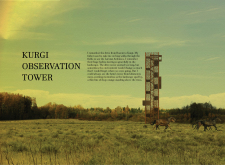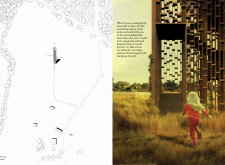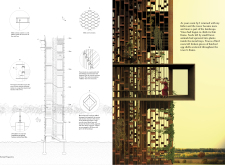5 key facts about this project
The site is located in the Latvian Ardennes, featuring a slender tower designed to serve as both a landmark and a gathering space. The design concept draws on a deep relationship with nature and memory, creating an attachment to the landscape. The tower invites exploration and promotes engagement with the surrounding environment, making it a focal point for visitors.
Integration with Landscape
- The tower uses a thin steel frame, providing a light appearance that fits well within the natural setting. This choice allows the structure to blend in with the surroundings, showing how the building interacts with its environment. Changes in light and weather create different moods, affecting how people perceive the site throughout the day and across the seasons.
Functional Ecosystem
- Rainwater trays are incorporated into the design, serving both a practical and ecological purpose. These trays create habitats for plants and animals, supporting local biodiversity. Visitors can actively engage with the space, fostering a sense of care for the environment and encouraging a connection to nature.
Narrative Through Design
- The tower embodies memory through features like the seed trays, which represent themes of growth and continuity. As the landscape evolves, so does the tower, telling a story of both human and natural history. This narrative connection enriches the experience, allowing visitors to reflect on their relationship with the place.
Dynamic Architectural Experience
- Climbing the tower offers expansive views of the surrounding landscape, enhancing the sense of connection between the built structure and nature. Each step upwards creates a changing perspective, emphasizing the tower’s role as a lively structure that adapts to its surroundings and the people who visit.
Visitors will find that moving from the base of the tower to its top reveals not just the beauty of the landscape, but also a well-considered journey that encourages interaction and reflection. The tower engages with nature while promoting a thoughtful experience of the environment around it.






















































